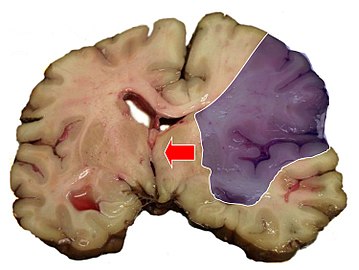Did you know?
You can double click on a word to look it up on TermGallery.
You can double click on a word to look it up on TermGallery.
Meanings of embolic stroke in inglês
russo
апоплектический удар português
acidente vascular cerebral catalão
accident vascular cerebral espanhol
apoplejía 
Problem with the arteries supplying blood to the brain.
Related terms
Usage of embolic stroke in inglês
1
Patients: 105 consecutive patients with acute embolic stroke affecting the anterior circulation.
2
Conclusions: EP-2104R-enhanced MRI successfully identifies intracranial thrombus in a rat embolic stroke model.
3
These emboli may be a risk factor for embolic stroke.
4
Thereafter, its prevalence was compared between patients with and without embolic stroke of undetermined source.
5
To date, 49 cases have been reported of embolic stroke with a PFE as the probable origin.
6
We report a 41-year-old woman with embolic stroke of the mid-pons attributed to embolism from vertebral artery dissection.
7
We hypothesize that TXNIP inhibition attenuates redox imbalance and inflammation and provides protection against a clinically relevant model of embolic stroke.
8
Conclusions: Occlusion of the LAA by the TP is feasible and effective in most patients with atrial fibrillation at high risk for embolic stroke.
9
An undertreatment with warfarin is reported in the prevention of embolic stroke in patients with chronic atrial fibrillation, and can be suspected for other indications.
10
Studies of clot composition of embolic strokes of undetermined strokes are lacking.
11
Conclusion: Early cardiac surgery may provide clinical advantages overcoming peri-operative risks in those with IE complicated with cardio- embolic strokes.
12
Methods: Embolic stroke was induced in adult rats by occlusion of the right internal carotid artery with an aged thrombus.
13
Embolic stroke of undetermined source (ESUS) is an important group of cryptogenic strokes that are in evidence due recent ongoing trials.
This collocation consists of:
Translations for embolic stroke
português
Embolic stroke across language varieties

United States of America
Common

